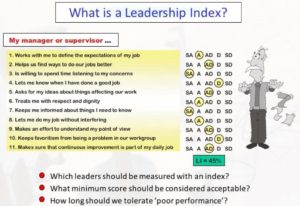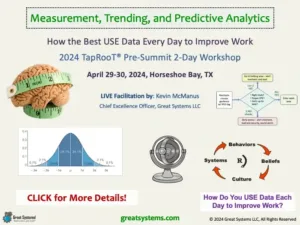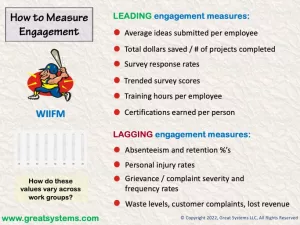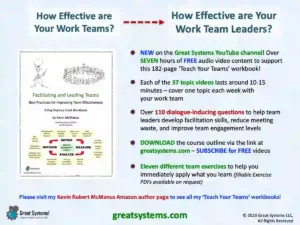Best Practices to Stay Union Free (or Attract One) … It’s Your Choice!
How we lead determines the need for labor organization. Best practices to stay union free exist. Too many leaders seem to ignore them. Do you have a union at your workplace? If so, it is likely that a unions was necessary in the past for fair work practices. Today, some workplaces still need them. Others don’t.
During my work life, I have worked in, and for, both organized and union-free companies. In some cases, we had some organized sites and others that were not. With all the labor organization efforts going on today, I thought I would share my best practices to stay union free. Plus, these are simply best practices to lead any workforce.
My perspective has always been that is if a company has a union in-house, at some point in time the company deserved one. Current management may lead in a much more positive way, but mental models from past negative interactions still exist. It is a challenge to undo twenty-plus years of bad management with just a few years of ‘good management’ attempts.
Like it or not, if you choose to continue to manage in a manner that could be perceived as even a bit authoritarian, entitled, non-inclusive, or unfair, a union could be in your future. I have learned that the following practices are effective in ANY workplace setting, organized or union-free.
My First Two Experiences with Organized Workplaces
I can’t take all the credit for the best practices I share here, by any means. Each of my first two employers was organized, with one union being small and the other being the United Auto Workers (UAW). As a ‘fresh out of university’ Industrial Engineer, I saw little difference in terms of how the union’s presence affected the performances of a given site.
Both Locals would file the same flavor mix of grievances – working hours, safety concerns, wage rate versus seniority, bid job rights, etc. There did not seem to be any significant difference in work rules or work practices. People could be happy or unhappy. Such happiness seemed to be driven mainly by where they worked and who they worked for, not by the union’s presence.
Both sites had improvement teams, but only a small percentage of the workforce was involved. By the turn of the century, both companies were out of business. Most people simply came to work each day, did their jobs, and went home.
Learning How to Design Work to Stay Union Free
My third employer was not organized. Such a status did not figure in my job selection process, but the five years I spent in that environment dramatically affected my career path. On an annual basis, we would have a lawyer from back East come in and teach us about how to stay union free. It was all legit and legal from a labor relations standpoint. We made rubber roofing, in a part of the country that had a strong United Rubber Workers (URW) presence.
Mr. Martin Payson, with Jackson Lewis LLP, taught those workshops. He went on to be a strong opponent of the Employee Free Choice Act. Mr. Payson felt that the act represented a fundamental attack on the principles of democracy, informed decision making, and the secret ballot.
He taught us that if we create workplaces that people want to be a part of and feel respected in, there is no need for a union. If leaders consistently hear and validate each staff member’s voice, there is no need for shop stewards. However, those are BIG ‘Ifs’.
Even More Labor Experiences
My fourth employer had the most challenging union environment of them all. On top of that, I was the Production Manager. Fortunately, we had a Plant Manager, Business Agent, and Chief Steward who were committed to building a stronger labor-management partnership. Unfortunately, the company was sold before we could complete our transitional journey.
Plus, I have worked with multiple organizations that are ‘hybrids’ in terms of a labor presence. In this model, some sites are organized, and some are not. If your organization has multiple sites in different states, the need for consistent union-free practices is high. This true whether a given site is organized or not.
An organized workplace can be pleasant and productive. That said, most leaders rightfully argue that some scheduling flexibility is lost. Conversely, leaders must invest time and money to maintain a union-free status, as the prevailing system of management often still leans towards the autocratic side.
However, it has consistently been my experience that if you effectively engage your people in meaningful change, you will reduce waste and increase profits. However, such success requires trust in each other. Leaders can generate such trust in either a unionized or union-free setting.
Here are my best practices to stay union free … or attract them. The choice is yours!
Best Practice #1 – Relationships Matter the Most!
If you want to stay union free, relationship quality matters most. Without sound relationships, trust is low. When trust is low, people begin to question their job security and the fairness of work. How often do you think about relationship quality at work?
Unfortunately, too many leaders view relationships as being ‘nice to have’, at best, in the world of work. Covey’s Emotional Bank Account concept provides a quick means of assessing relationship quality at work. The key is that EACH work team leader, regardless of leadership level, works to consistently build strong relationships with their teams.
What percent of your staff do you have a positive emotional account balance with? What percent fall into the negative balance category? Can you think of negative events (withdrawals) that helped create such debt? How often do you make efforts to make deposits in the emotional bank accounts of your team members?
Best Practice #2 – Be Fair
Opportunities for people to be fair with each other occur every day in the workplace. Effective teamwork, in the most basic sense, is nothing more than people being fair in terms of sharing the workload. Every leader decision must consider the fairness element. That said, favoritism remains a common workplace challenge.
Fairness is most often viewed through a ‘who gets to do what work for what hours and pay’ lens. Plus, people consider job flexibility – when can they take personal time, if even just for fifteen minutes. My experience has been that a lack of communication about job expectations often heads the list of fairness concern causes.
Similarly, pay rates often lead the list of unfair compensation topics. However, other elements of the compensation package are often more one-sided than the pay differences that exist. Leaders should view all elements of the compensation package through a fairness lens. After all, that is what their people do every day. Finally, be transparent as to how work is measured and how allowances are made.
Stay Union Free Best Practice #3 – Be Both Honest AND Transparent
The two words have different meanings, even though some people use them interchangeably. To be honest is to tell the truth. To be transparent is to share a complete, and accurate, set of information so understanding exists. Management decisions provide perhaps the best opportunity to practice both behaviors. Some managers flat out lie. Others simply fail to share all key facts with you. Both are bad practices.
For starters, be honest. White lies don’t work in the world of work. The social media grapevine can defeat any corporate spin machine. Misinformation and misrepresentation are strong dissatisfiers these days to most workforce demographics. In society, we can walk away from (or turn off) such nonsense. In the workplace, we often live with its effects and aftereffects every day. As Covey taught me, trust is built through character and competency demonstration.
Has anyone ever said to you that certain information was ‘need to know’ or ‘above your poor grade’? How often do you wonder how management makes the decisions they make? People challenge transparent decision-making processes to a much lesser degree than those that occur behind closed doors. Do your people ask you why they need to do work a certain way? If so, you probably need to make transparency improvements.
Great Book: The Eighth Habit – From Effectiveness to Greatness, by Dr. Stephen R. Covey
Stay Union Free Best Practice #4 – Be Inclusive
The data speaks for itself. One demographic segment tends to dominate the leadership ranks in most organizations. This is a sign of tradition, not true potential. Change is in process, but I suspect it will require another generation of time (20 years) to complete the transition. Even then, many smaller, more rural workplaces will still just be starting to shift.
Appreciate the value that diversity brings to the workplace. Ask – listen – learn. I grew up in the rural South, in the 1960s. Fortunately, the two ethnic groups in our community seemed to get along well, despite the obvious segregation and economic differences. That said, inclusiveness was not a workplace goal back then. Also, I came to learn that two ethnic groups on a team is not truly that diverse.
In my last full-time Plant Manager job, people from ten different countries made up our Operations team. It was the best workforce I had ever been a part of, and I had worked with a few great ones. Our diversity contributed to our creativity and comradeship. As we doubled in size, our team understood why we had to work some strange schedules because they had been kept informed and involved. Everyone is good at something.
Stay Union Free Best Practice #5 – Practice Consistent, Meaningful Engagement
Relationships cannot be developed, let alone nurtured, without consistent, meaningful engagement. Engagement factors provide the focus areas for connecting with staff on a regular basis. Unfortunately, few organizations measure engagement at all, let alone identify engagement factors.
Formally identify key engagement factors for your different demographic groups. More importantly, provide a variety of ways for people to engage. Not everyone wants to be on an improvement team. Some folks prefer regular text notifications with links. Others prepare face-to-face messaging. Almost all staff prefer regular, versus spotty, opportunities to learn and share. With social media, it’s easy to set up interest groups that allow plenty of chances for asynchronous, but meaningful, engagement.
Use multiple means to measure engagement on a daily, weekly, and monthly basis. Assess your existing engagement processes. Also, work with your people to further enhance engagement approach design and execution. Most importantly, formally review and refreshen your engagement approaches on at least an annual basis.
Stay Union Free Best Practice #6 – Appreciate the Need for, and Promote, Work / Life Balance
People have dreamed of a better work / life balance long before it became the hot topic it is today. From a management perspective, it is often the biggest gripe. We don’t get paid for overtime work, even though our boss expects it. In many cases, to put job ahead of family means you are a loyal employee and worthy of promotion. In some cases, 80-hour weeks are still the norm.
The greatest mistake I see leaders make is to blindside their people with changes in work hours. Worse yet, some people receive discipline when they fail to show following such adjustments, even when their boss failed to inform them of the change. People lead busy lives, and yes, some may overextend themselves. That said, it’s their choice to do so.
When a leader appreciates the ‘away from work’ demands of their team, it makes a huge difference in relationship quality. Ideally, the organization should clearly define work hour boundaries. The waste reduction one gains from fatigue minimization alone usually makes the change worth it, even before other benefits from lower stress and greater focus come along.
Best Practice #7 – Play the Great Game of Business
I learned to practice the ‘great game of business’ a few years before Jack Stack published his book by that name. Open book management began in the early 1990s when Jack Stack used it to help turn around the Springfield Remanufacturing facility in Missouri. “Get the information out there’ is a key OBM first step to take. Plus, it is one great way to help stay transparent, and in turn, union free.
Performance reviews, pre-job huddles, and improvement teams are three key elements of open book management. More importantly, these techniques help empower others and build ownership relative to daily process performance and improvement. As time progresses, you may want to teach your people about how the organization makes and loses money. Such a business literacy extension goes beyond a simple understanding of one’s daily process costs.
You don’t have to share exact costs or proprietary information. Simply sharing percentages and rounded off data goes a long way towards helping people understand resource requirements and limitations. When you share compensation data, include the total compensation picture in a cost per hour format. Often, people experience shock when they learn that benefits costs are often equal to as much 50% of their total wages.
Stay Union Free Best Practice #8 – Change the Daily Conversations
What conversation sound bites do you hear at work? For example, it is a bad thing to hear the phrase ‘Not in my job description’ in the breakroom at any time, let alone on a regular basis. Frequently hearing blame being placed on people for problems provides another ‘bad conversation’ example. This is one reason why front-line leadership is key to staying union free. They must both listen to what people say and model the desired ‘conversations.’
One way to do this is regularly engage all team members in formal problem solving. This could be as simple as a 30-minute brainstorming session during a downtime period. Plus, leaders should regularly request improvement ideas and actually put some of them in place. Better yet, they should redesign their own jobs to help stay in connection with their people and processes.
Sadly, too many leaders only talk to their people when there is a problem. Don’t let this be the case if you want to stay union-free. Expect leaders to consistently spend 70% of their work time with one or more of their people. Define Leader Standard Work plans to help facilitate a change in how time is spent each day at work.
As Far as Union Decertification Goes …
Personally, I do not think management should waste their time with attempts to de-certify a union that is in place. Instead, they should make every effort possible to identify, prioritize, and improve the key workforce dissatisfiers that exist. Time limits exist, and time is not available to tackle both strategies at once.
Remember, unions are often artifacts of the past. Many times, current leadership manages in a totally different way than those managers who were in place when the union first formed. It has just not been worth the effort to de-certify. Conversely, if union leadership refuses to cooperate even when management does its best to improve, de-certification attempts might become value added.
Will There Ever be a Union-Free Future?
I firmly believe that companies become organized because they deserve it. People devote most of their waking hours to their job. As leaders, we should follow the Golden Rule – treat each other as we would like to be treated. Status, ethnicity, experience, gender, job title, or even location of birth should not determine if someone can be involved in workplace change efforts or not.
We forget our history. Time erases our memories of how bad management once was. Just a little over 100 years has passed since the Triangle Shirt Works fire in New York City. Only seventy years ago, Andrew Carnegie turned George Frick loose on rioters in front of his steel plants. A massive, unexplainable compensation difference exists in the United States to this day between executives and front-line staff – between people and other people.
I’ve worked with unions that cause me no issue. I can help my team achieve operational excellence with a union in place or without one. The union should not, and is not, the system constraint. However, the way we as leaders treat people at work each day is perhaps a constraint that is the most challenging to remove.
Focus on Building Sound Relationships, Not Staying Union Free
People give you so much more at work each day than what your naked eye can see. Conversely, if they are dissatisfied, they will take more from your organization than you will ever know. It’s not a threat. It’s simply the realities of how fairness, or the lack thereof, influences one’s performance on the job each day at any organization level.
Workplaces that are fair, fun, and focused on excellence are possible. Plus, you can even find them and experience them if one looks hard enough. They’re just not the norm. Where is your workplace at today? What would your people say if we asked them the same question?
Keep improving!
Kevin McManus, Chief Excellence Officer, Great Systems
WATCH over 50 kaizen and workplace health improvement videos on my Great Systems YouTube channel.
CHECK OUT my ‘Teach Your Teams’ workbooks on Amazon.com
LIKE Great Systems on Facebook
© Copyright 2024, Great Systems LLC, All Rights Reserved








